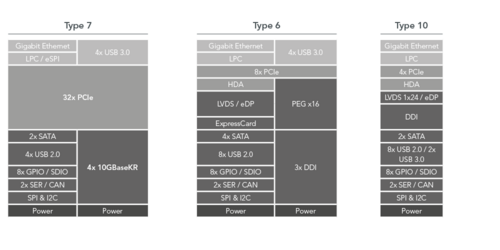
COM Express Type 7
With the new revision 3.0 of the most successful Computer-on-Module standard a new pinout Type is added to extend the reach of COM Express to server Type applications.
COM Express is a Computer-on-Module standard defined by the PICMG consortium (www.picmg. org). The first version was release in 2005 with updates in 2010 and 2012. The upcoming revision 3.0 defines 4 different sizes and 3 pinouts.
The new Type 7 is not a replacement for the well-established Type 6 pinout. It trades all audio and video interfaces for four 10G Ethernet ports and a total of 32 PCI Express lanes in order to support enhanced micro servers and other server Type applications that only allow for low power consumption but require high computing performance and communication throughput.
Check out our conga-X7 Evaluation carrier board for COM Express Type 7 modules.
Have a look at our COM Express Type 7 Basic modules here
COM Express Sizes
- Mini 84 x 55 mm²
- Basic 95 x 125 mm²
- Compact 95 x 95 mm²
- Extended 110 x 155 mm²
COM Express Pinouts
The PICMG specification defines different pinout Types in order to fulfill application specific demands. The pinout Types 1, 3, 4 and 5 are considered as legacy and are not used for new designs any longer. Products featuring older pinout Types are still available and refer to the revision 2.1 of the COM Express specification.
| Type | Rows | PCIe | SATA | LAN 1G / 10G | USB 2.0 / 3.0 | Display |
|---|---|---|---|---|---|---|
| 10 | AB | 4 | 2 | 1 / - | 8 / 2 | LVDS/eDP, DDI |
| 6 | AB/CD | 24 | 4 | 1 / - | 8 / 4 | VGA, LVDS, PEG, 3x DDI |
| 7 | AB/CD | 32 | 2 | 1 / 4 | 4 / 4 |
Real Live Size / Pinout Combinations
| Mini 84x55mm² | Compact 95x125mm² | Basic 95x125mm@ | Extended 110x155mm² | ||
|---|---|---|---|---|---|
| Type 10 | ++ | ||||
| Type 6 | ++ | ++ | |||
| Type 7 | ++ | possible |
The Mini size was introduced with Rev. 2.1 and is only implemented for the single connector pinout Type 10. The most popular pinout today is Type 6 which replaced the legacy Type 2 computing modules.
The extended size definition of 110x155mm² did not reach market relevance in the past. With the new, server oriented pinout Type 7 which is defined in the COM Express specification rev. 3.0, this might come in to play as server Type applications require more DRAM capacity and also look for more extreme CPU performance levels. COM Express supports a maximum of 137 Watt power consumption. The larger size provides more real estate for more memory and allows for better heat transmission to support higher power consumption. When comparing the new Type 7 pinout to the Type 6 pinout it becomes visible that this will not be a replacement. It’s a definition that clearly targets headless server applications with low power consumption, high computing density and high I/O throughput.
When compared to Type 6 the new Type 7 definition removes all audio and video interfaces, the upper 4 USB 2.0, ExpressCard and the upper 2 SATA ports. This releases 60 pins on the AB connector and another 42 pins on the CD connector. These 102 newly released pins, in combination with some previously reserved pins, have been used to add extra PCI Express lanes and four 10 GB Ethernet KR lanes with a complete set of NC-SI sideband signals.
Type 7 COM Express modules can provide a maximum of features
- 4x 10GBaseKR Ethernet with NC-SI
- 1x 1GB Ethernet
- 32x PCI Express 3.0 Lanes
- 2x SATA
- 8x GPIO shared with SDIO
- 2x Serial shared with CAN
- LPC bus shared with eSPI
- SPI and I²C bus
COM Express Type 7 modules
Sign up here to get more information about the new COM Express Type 7 Standard






